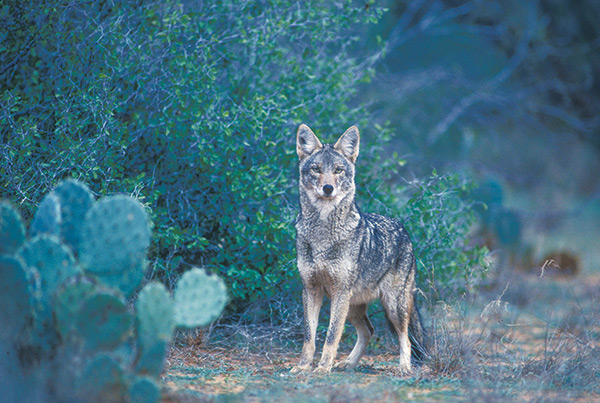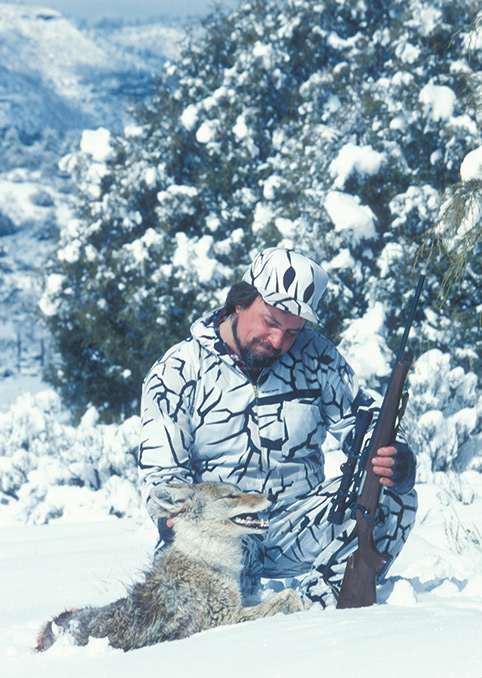 Predator Hunting: Calling Predators Away from Roads
Predator Hunting: Calling Predators Away from Roads
By Judd Cooney

My first howl was answered immediately from a ridge a half-mile off the road. I drove up the road a mile, swapped places with my hunting partner, and he drove us back toward where we had been. Along the way, he slowed enough that I could slip out of the passenger side door near an elk carcass we had dropped by the road where it was hidden by a 4-foot-high embankment of snow that had been plowed off by the county road crew.
I set up in the planned ambush on the opposite side of the carcass, a slightly elevated but hidden stand with a great view across an open field.
My first sequence of squeals and squalls was still echoing when a coyote came trotting down the oakbrush slope of a distant ridge. The big dog stopped on the dike of a still-distant irrigation ditch. I tried every sound I could coax out of three mouth calls and a diaphragm call. The coyote didn’t move one inch closer.
My mistake had been howling alongside a well-travelled county road. Even with a fresh road-killed cow elk for enticement, that coyote wasn’t crossing a vast open field. In all likelihood, the combination of regular daytime vehicle traffic and the fact that a few locals and the landowner who had given us permission to set up our ambush had been taking potshots at any coyote caught out in the open. This had made the coyote road-wary.
That same open field eliminated any chance of my stalking closer, so I snugged the forearm of my 220 Swift in the soft snow on top of a hard berm and packed more snow under the butt for a solid rest. A range finder indicated the shot would be just over 550 yards. There was no wind, and the coyote was sitting upright facing me, offering a very makeable if long shot for the pinpoint accurate rifle and a carefully tailored long-range Swift handload. I held a bit high, put final pressure on the trigger, and saw snow kick up on the slope behind the coyote.
Seemingly in slow motion, the coyote toppled over. Not a shot of choice, but the longest I have ever made.
As we drove out to pick up the coyote, I couldn’t believe the profusion of tracks and trails that crisscrossed the snowy field. They left no doubt that more coyotes were feeding on the elk carcass though no doubt mostly feeding at night.
Spooked, road-wary predators are becoming more common thanks to the number of neophyte or just less than serious hunters who play recorded sounds with electronic callers. The calls do a good job of bringing in predators, but the habitual routine of parking, howling, and then getting out for a hasty roadside stand is also educating predators to the danger in those calls.
The elk carcass was only 5 miles from my house. I checked it very day after that and found fresh coyote sign every time. I drafted a plan of attack to get more shots.
The section I had permission to hunt was 2 miles by 2 miles, bisected by the ridge. There was rimrock and oakbrush on the highway side and oakbrush interspersed with Ponderosa timber on the backside. My secretary followed me to the upper end of the ridge where it crossed the highway. I parked my truck there, and she drove me to the other far end of the ridge and dropped me off there.
With a slight breeze in my face, I hiked 400 yards or so to the top of the ridge and set up where the sound of my calling would reach both sides. This time, I was toting a lightweight, fast-handling and deadly accurate .222 Model Seven Remington. I wished it had a suppressor on the muzzle to keep shot noise at a minimum, but it didn’t.
My first series of very low jackrabbit squalls was hanging in the air when a big dog came busting out of the brush. He hesitated at 50 yards, just long enough for me to end his depredating days.
Confident of my chances, I had brought an empty daypack. A half-hour later, the pelt was in that pack and I was ready for another encounter. Skinning on the fly is essential for keeping long hike-in hunts enjoyable, and a fresh pelt hanging over a branch or bush doesn’t make a bad decoy in the right situation.
The second setup was a bust even though plenty of tracks indicated coyotes at that location, too.
The third ambush was a repeat of the first, only this time two coyotes came running out of the rimrock. I dumped the first at 40 yards and the second vanished in oakbrush before I could get on it.
I took my final stand where the ridge dropped off toward the road in a jumble of ledges, rock clefts, boulders and more dense oakbrush. I had taken bobcats on this well-used crossing travelway and had two bobcat snare pens there now, one on each side of the road.
My calling got no response, and I was about to give up and check the snares when movement in the oaks 100 yards down the slope caught my eye. I switched to binoculars just in time to watch a large tom bobcat ease out of the brush and then take a seat. The cat was being super cautious, what with all of the coyotes in the area. That caution wasn’t enough.
A 52-grain slug through the chest anchored the big tom on the spot. This made the decision to return for another go round a no brainer. My hunting compadres and I ended up taking a half-dozen more coyotes off that ridge.
I have used this technique successfully a number of times in various parts of the country, pretty much anywhere I find an area that looks like prime predator habitat that is maybe getting hit hard by road-hugging hunters. Hiking in well off the road before howling or calling gets me shots at pressured predators other hunters educate to avoid the road during the day.
On a recent trip to North Dakota, I hunted with a college buddy who lives up there. We enjoyed a couple of good calling days and had taken several coyotes and a couple of fox. While making the rounds, we had driven past several alluring sections with large sloughs and lake beds, rocky prairie that had been “set aside” as not worth the cost of farming.
My partner had to attend a work meeting one morning, and that meant I would be hunting solo. Before going to the meeting, he followed me out to where I parked my truck by a section enrolled in the Conservation Reserve Program. Then he drove me to a section not far from where he lived and dropped me off to hunt the several miles of rough country in between.
My first stand was off the road in volcanic rock overlooking a 100-yard slough that was sure to hold pheasants. Even though the slough was a little closer to the road than I preferred, 4 inches of fresh snow was trodden down with fox tracks going to and from the roadway and slough. With the rock pile for a vantage, it was just too good a setup to pass.
I held the call volume down for 10 minutes and then blasted a final sequence at close to maximum volume. Following a few minutes of silence, I picked up the faint sound of a coyote howl emanating from a dense stand of grassy CPR and rocky outcroppings a half-mile or so across the section. I resumed calling but lost patience after a half-hour. I slipped through a series of gullies and ravines to the shady side of a closer rock pile overlooking a bunch of small weed-and-reed-choked frozen sloughs.
The first jackrabbit distress cries brought a coyote out to the edge of an acre of dense grass and weeds. He paused, but caution overcame curiosity and he came my way on the run. At 40 yards he bounced to a stop, perfectly posed for a can’t-miss broadside shot. A few minutes later, I was skinning that coyote.
Three quarters of the way to the next road, another coyote made the same mistake and also ended up in my day pack. Not bad for a morning hiking through a place I had never hunted before.
According to my compadre, the oil boom in North Dakota has led to a proliferation of oil wells and new roads spider webbing the countryside. This and the accompanying vehicle traffic has changed predator hunting in the state. The surge of oil field workers, many of whom tote rifles and aren’t bashful about using them, has had the most impact on public land where you don’t need to ask for permission.
This same phenomenon has impacted northwestern Colorado where I once outfitted pronghorn bowhunters. BLM lands are now dotted with oil rigs and wells and cross hatched with roads that run through some of the best coyote calling country I ever hunted.
During my last pronghorn hunt in that area, I found one of my favorite little canyons for calling predators—a place where I had averaged a couple of coyotes per hunt during early fall and where a partner and I once took four prime coyotes on a January morning—transformed by the oil development. A road ran down the middle of a once rugged and roadless canyon that had seemed safe from any development. The road led to and then connected a half-dozen oil well sites complete with pumps, tanks and daily vehicle traffic.
Such areas may still be hunted with stealth, patience and smarts. I keep my tactics as low-key and unobtrusive as possible from start to finish. The use of binoculars for remote scouting and then while calling is essential. Spotting incoming critters at a distance allows me to adjust strategy on the fly to accommodate changed conditions on the ground.
I use a howler on occasion, especially late in the season, but I keep that very low key. I howl once and wait at least 10 minutes for sight or sound of a response. If I hear a response but nothing shows, after another 10 minutes or so I either switch to calling with prey distress sounds or, if good cover is available, I move closer to the suspected location of the response before setting up and again calling with distress sounds.
I use both mouth and electronic calls. Regardless of which I use, I keep the volume low and sequences short. Being less intrusive lets me hunt such areas without attracting unwanted notice, and with patience and perseverance, the approach often pays.
Past experience has shown time and time again that when a coyote responds in an off-highway area, it may come in at a faster pace with less caution. I believe this is because the call sounds are emanating from areas where other hunters are rarely if ever encountered.
Despite rapidly changing conditions from the provinces of Canada to the desert country of Mexico, from the East Coast to the West Coast, I can’t recall ever going on a predator hunting venture when I didn’t see areas that begged to be called and hunted. Hiking in to hunt places that don’t get pressure provides a challenge and also opportunity for the predator hunter who is willing to go the extra mile.
